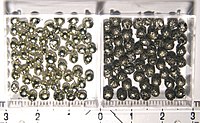
Photo from wikipedia
Tin(IV) tricycles form a class of structurally unique and topologically attractive molecules with challenging synthetic attributes. Particularly, “stannatranes and pseudostannatranes” are among the most intensively studied representatives of tin(IV) tricycles.… Click to show full abstract
Tin(IV) tricycles form a class of structurally unique and topologically attractive molecules with challenging synthetic attributes. Particularly, “stannatranes and pseudostannatranes” are among the most intensively studied representatives of tin(IV) tricycles. In light of recent research perspectives, this review discusses the progress of stannatranes and pseudostannatranes over the past decades. Herein, stannatranes and pseudostannatranes are arranged into various groups based on their cage skeletons. The synthetic aspects of stannatranes are summarized for different categories of ligating systems, viz. stannatranes with nitrilotriethanolate cages, aminotricarboxylate cages, and substituted nitrilotriethanolate cages. Likewise, detailed synthetic discussions of pseudostannatranes are presented in subsequent sections, comprising [3.3.3.01,5], [4.3.3.01,5], [4.4.3.01,5] and [4.4.4.01,6] cages. Further, intriguing features of stannatranes and pseudostannatranes, such as variation in the Sn–N transannular bond, oligomerization, extended exocyclic bonds, aqueous chemistry and unique spectroscopic aspects, are explained with appropriate examples. Stannatranes possess interesting structural topologies and physical features which can be tuned by controlling the rigidity/flexibility of the ligating system. The choice of the rigid skeleton mitigates oligomerization effects and allows access to highly stable monomeric frameworks. The stability of these systems in aqueous systems facilitates the formation of new hydrolytic species and allows chemical reactivity of the exocyclic bond to obtain new stannatranes.
Journal Title: New Journal of Chemistry
Year Published: 2020
Link to full text (if available)
Share on Social Media: Sign Up to like & get
recommendations!